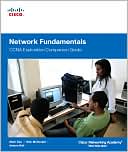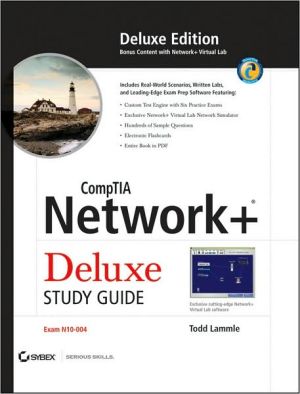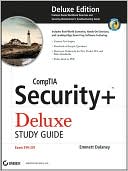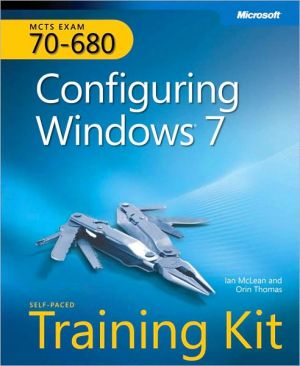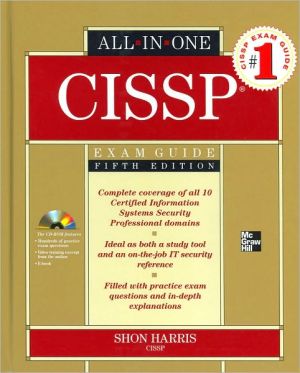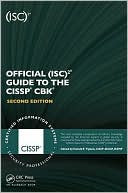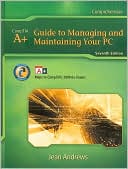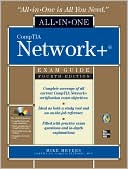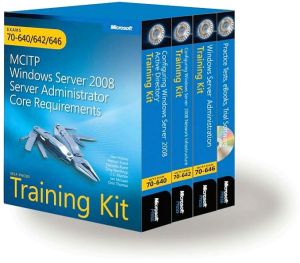Network Fundamentals: CCNA Exploration Companion Guide (Companion Guide Series)
Search in google:
Network Fundamentals, CCNA Exploration Companion Guide is the official supplemental textbook for the Network Fundamentals course in the Cisco® Networking Academy® CCNA® Exploration curriculum version 4. The course, the first of four in the new curriculum, is based on a top-down approach to networking. The Companion Guide, written and edited by Networking Academy instructors, is designed as a portable desk reference to use anytime, anywhere. The book’s features reinforce the material in the course to help you focus on important concepts and organize your study time for exams.New and improved features help you study and succeed in this course: Chapter objectives—Review core concepts by answering the focus questions listed at the beginning of each chapter. Key terms—Refer to the updated lists of networking vocabulary introduced and highlighted in context in each chapter. Glossary—Consult the comprehensive glossary with more than 250 terms. Check Your Understanding questions and answer key—Evaluate your readiness with the updated end-of-chapter questions that match the style of questions you see on the online course quizzes. The answer key explains each answer. Challenge questions and activities—Strive to ace more challenging review questions and activities designed to prepare you for the complex styles of questions you might see on the CCNA exam. The answer key explains each answer. How To—Look for this icon to study the steps you need to learn to perform certain tasks.Packet Tracer Activities— Explore networking concepts in activities interspersed throughout some chapters usingPacket Tracer v4.1 developed by Cisco. The files for these activities are on the accompanying CD-ROM.Also available for the Network Fundamentals CourseNetwork Fundamentals, CCNA Exploration Labs and Study GuideISBN-10: 1-58713-203-6ISBN-13: 978-1-58713-203-2Companion CD-ROMThe CD-ROM provides many useful tools and information to support your education: Packet Tracer Activity exercise files v4.1 VLSM Subnetting Chart Structured Cabling Exploration Supplement Taking Notes: a .txt file of the chapter objectives A Guide to Using a Networker’s Journal booklet IT Career Information Tips on Lifelong Learning in Networking This book is part of the Cisco Networking Academy Series from Cisco Press®. The products in this series support and complement the Cisco Networking Academy online curriculum.
IntroductionChapter 1 Living in a Network-Centric WorldObjectivesKey TermsCommunicating in a Network-Centric WorldNetworks Supporting the Way We LiveExamples of Today’s Popular Communication ToolsNetworks Supporting the Way We LearnNetworks Supporting the Way We WorkNetworks Supporting the Way We PlayCommunication: An Essential Part of Our LivesWhat Is Communication?Quality of CommunicationThe Network as a PlatformCommunicating over NetworksElements of a NetworkConverged NetworksThe Architecture of the InternetThe Network ArchitectureFault-Tolerant Network ArchitectureScalable Network ArchitectureProviding Quality of ServiceProviding Network SecurityTrends in NetworkingWhere Is It All Going?Networking Career OpportunitiesSummaryActivities and LabsCheck Your UnderstandingChallenge Questions and ActivitiesTo Learn MoreChapter 2 Communicating over the NetworkObjectivesKey TermsThe Platform for CommunicationsThe Elements of CommunicationCommunicating the MessagesComponents of the NetworkEnd Devices and Their Role on the NetworkIntermediary Devices and Their Role on the NetworkNetwork MediaLANs, WANs, and InternetworksLocal-Area NetworksWide-Area NetworksThe Internet: A Network of NetworksNetwork RepresentationsProtocolsRules That Govern CommunicationsNetwork ProtocolsProtocol Suites and Industry StandardsInteraction of ProtocolsTechnology-Independent ProtocolsUsing Layered ModelsThe Benefits of a Layered ModelProtocol and Reference ModelsTCP/IP ModelCommunication ProcessProtocol Data Units and EncapsulationSending and Receiving ProcessOSI ModelComparing the OSI Model to the TCP/IP ModelNetwork AddressingAddressing in the NetworkGetting Data to the End DeviceGetting Data Through the InternetworkGetting Data to the Right ApplicationSummaryActivities and LabsCheck Your UnderstandingChallenge Questions and ActivitiesTo Learn MoreChapter 3 Application Layer Functionality and ProtocolsObjectivesKey TermsApplications: The Interface Between the NetworksOSI and TCP/IP ModelApplication Layer SoftwareUser Applications, Services, and Application Layer ProtocolsApplication Layer Protocol FunctionsMaking Provisions for Applications and ServicesClient/Server ModelServersApplication Layer Services and ProtocolsPeer-to-Peer (P2P) Networking and ApplicationsApplication Layer Protocols and Services ExamplesDNS Services and ProtocolWWW Service and HTTPE-Mail Services and SMTP/POP ProtocolsE-Mail Server Processes: MTA and MDAFTPDHCPFile-Sharing Services and SMB ProtocolP2P Services and Gnutella ProtocolTelnet Services and ProtocolSummaryActivities and LabsCheck Your UnderstandingChallenge Questions and ActivitiesTo Learn MoreChapter 4 OSI Transport LayerObjectivesKey TermsRoles of the Transport LayerPurpose of the Transport LayerSupporting Reliable CommunicationTCP and UDPPort AddressingSegmentation and Reassembly: Divide and ConquerTCP: Communicating with ReliabilityMaking Conversations ReliableTCP Server ProcessesTCP Connection Establishment and TerminationTCP Three-Way HandshakeTCP Session TerminationTCP Acknowledgment with WindowingTCP RetransmissionTCP Congestion Control: Minimizing Segment LossUDP: Communicating with Low OverheadUDP: Low Overhead Versus ReliabilityUDP Datagram ReassemblyUDP Server Processes and RequestsUDP Client ProcessesSummaryLabsCheck Your UnderstandingChallenge Questions and ActivitiesTo Learn MoreChapter 5 OSI Network LayerObjectivesKey TermsIPv4Network Layer: Communication from Host to HostIPv4: Example Network Layer ProtocolIPv4 Packet: Packaging the Transport Layer PDUIPv4 Packet HeaderNetworks: Dividing Hosts into GroupsCreating Common GroupsWhy Separate Hosts into Networks?Dividing Networks from NetworksRouting: How Data Packets Are HandledDevice Parameters: Supporting Communication Outside the NetworkIP Packets: Carrying Data End to EndGateway: The Way Out of the NetworkRoute: A Path to a NetworkDestination NetworkNext Hop: Where the Packet Goes NextPacket Forwarding: Moving the Packet Toward Its DestinationRouting Processes: How Routes Are LearnedStatic RoutingDynamic RoutingRouting ProtocolsSummaryLabsCheck Your UnderstandingChallenge Questions and ActivitiesTo Learn MoreChapter 6 Addressing the Network: IPv4ObjectivesKey TermsIPv4 AddressesAnatomy of an IPv4 AddressBinary-to-Decimal ConversionDecimal-to-Binary ConversionsAddressing Types of Communication: Unicast, Broadcast, MulticastIPv4 Addresses for Different PurposesTypes of Addresses in an IPv4 Network RangeSubnet Mask: Defining the Network and Host Portions of the AddressPublic and Private AddressesSpecial Unicast IPv4 AddressesLegacy IPv4 AddressingAssigning AddressesPlanning to Address the NetworkStatic or Dynamic Addressing for End-User DevicesSelecting Device AddressesInternet Assigned Numbers Authority (IANA)ISPsCalculating AddressesIs the Host on My Network?Calculating Network, Hosts, and Broadcast AddressesBasic SubnettingSubnetting: Dividing Networks into Right SizesSubnetting a SubnetTesting the Network LayerPing 127.0.0.1: Testing the Local StackPing Gateway: Testing Connectivity to the Local LANPing Remote Host: Testing Connectivity to Remote LANTraceroute (tracert): Testing the PathICMPv4: The Protocol Supporting Testing and MessagingOverview of IPv6SummaryLabsCheck Your UnderstandingChallenge Questions and ActivitiesTo Learn MoreChapter 7 OSI Data Link LayerObjectivesKey TermsData Link Layer: Accessing the MediaSupporting and Connecting to Upper-Layer ServicesControlling Transfer Across Local MediaCreating a FrameConnecting Upper-Layer Services to the MediaStandardsMAC Techniques: Placing Data on the MediaMAC for Shared MediaMAC for Nonshared MediaLogical Topology Versus Physical TopologyMAC: Addressing and Framing DataData Link Layer Protocols: The FrameFraming: Role of the HeaderAddressing: Where the Frame GoesFraming: Role of the TrailerSample Data Link Layer FramesPutting It All Together: Following Data Through an InternetworkSummaryLabsCheck Your UnderstandingChallenge Questions and ActivitiesTo Learn MoreChapter 8 OSI Physical LayerObjectivesKey TermsPhysical Layer: Communication SignalsPurpose of the Physical LayerPhysical Layer OperationPhysical Layer StandardsPhysical Layer Fundamental PrinciplesPhysical Signaling and Encoding: Representing BitsSignaling Bits for the MediaEncoding: Grouping BitsData-Carrying CapacityPhysical Media: Connecting CommunicationTypes of Physical MediaCopper MediaMedia ConnectorsSummaryLabsCheck Your UnderstandingChallenge Questions and ActivitiesTo Learn MoreChapter 9 EthernetObjectivesKey TermsOverview of EthernetEthernet: Standards and ImplementationEthernet: Layer 1 and Layer 2Logical Link Control: Connecting to the Upper LayersMAC: Getting Data to the MediaPhysical Implementations of EthernetEthernet: Communication Through the LANHistoric EthernetLegacy EthernetCurrent EthernetMoving to 1 Gbps and BeyondEthernet FrameFrame: Encapsulating the PacketEthernet MAC AddressHexadecimal Numbering and AddressingAnother Layer of AddressingEthernet Unicast, Multicast, and BroadcastEthernet MACMAC in EthernetCSMA/CD: The ProcessEthernet TimingInterframe Spacing and BackoffEthernet Physical Layer10- and 100-Mbps Ethernet1000-Mbps EthernetEthernet: Future OptionsHubs and SwitchesLegacy Ethernet: Using HubsEthernet: Using SwitchesSwitches: Selective ForwardingAddress Resolution Protocol (ARP)Resolving IPv4 Addresses to MAC AddressesMaintaining a Cache of MappingsARP Broadcast IssuesSummaryLabsCheck Your UnderstandingChallenge Questions and ActivitiesTo Learn MoreChapter 10 Planning and Cabling NetworksObjectivesKey TermsLANs: Making the Physical ConnectionChoosing the Appropriate LAN DeviceDevice Selection FactorsDevice InterconnectionsLAN and WAN: Getting ConnectedMaking LAN ConnectionsMaking WAN ConnectionsDeveloping an Addressing SchemeHow Many Hosts in the Network?How Many Networks?Designing the Address Standard for Your InternetworkCalculating the SubnetsCalculating Addresses: Case 1Calculating Addresses: Case 2Device InterconnectionsDevice InterfacesMaking the Device Management ConnectionSummaryLabsCheck Your UnderstandingChallenge Questions and ActivitiesTo Learn MoreChapter 11 Configuring and Testing Your NetworkObjectivesKey TermsConfiguring Cisco Devices: IOS BasicsCisco IOSAccess MethodsConfiguration FilesIntroducing Cisco IOS ModesBasic IOS Command StructureUsing CLI HelpIOS Examination CommandsIOS Configuration ModesApplying a Basic Configuration Using Cisco IOSNaming DevicesLimiting Device Access: Configuring Passwords and BannersManaging Configuration FilesConfiguring InterfacesVerifying ConnectivityTest the StackTesting the InterfaceTesting the Local NetworkTesting Gateway and Remote ConnectivityTracing and Interpreting Trace ResultsMonitoring and Documenting NetworksBasic Network BaselinesCapturing and Interpreting Trace InformationLearning About the Nodes on the NetworkSummaryLabsCheck Your UnderstandingChallenge Questions and ActivitiesTo Learn MoreAppendix Check Your Understanding and Challenge Questions Answer KeyGlossary1587132087 TOC 10/10/2007
